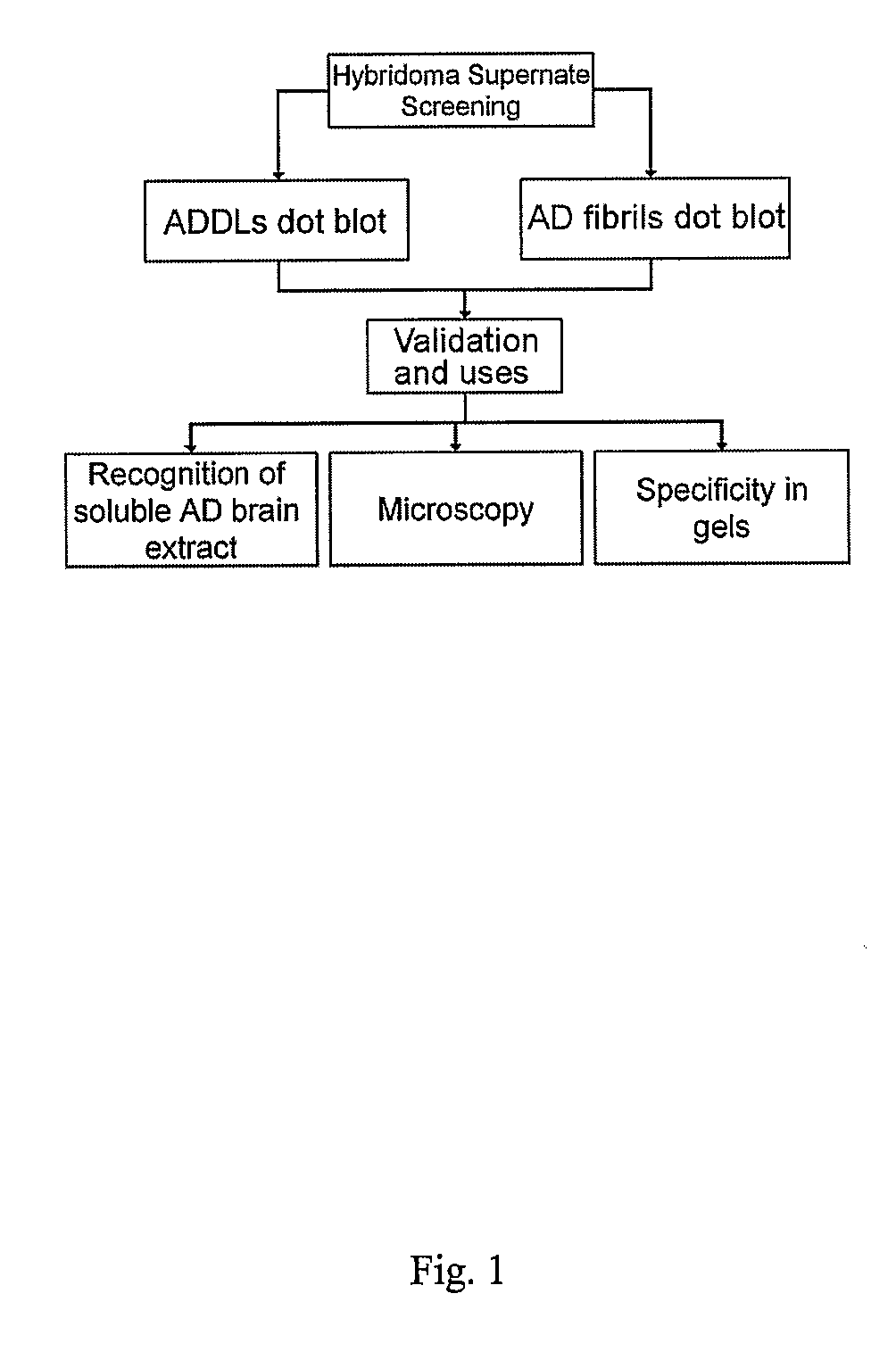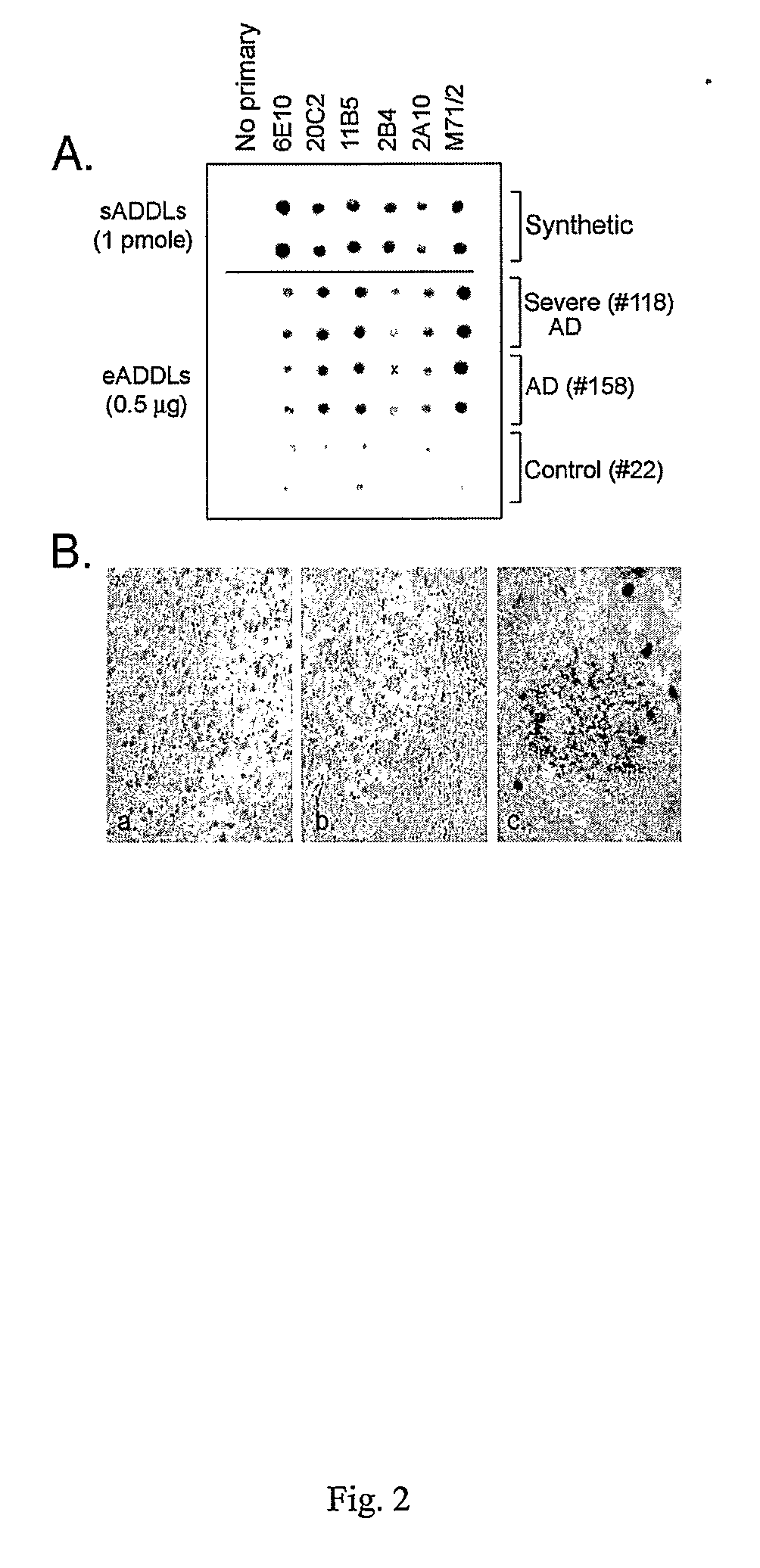Monoclonal Antibodies That Target Pathological Assemblies Of Amyloid B (Abeta)
a monoclonal antibody and amyloid b technology, applied in the field of biology and medicine, can solve the problem that compounds can interfere with the assembly of oligomers, and achieve the effect of improving the stability and stability of the oligomer assembly
- Summary
- Abstract
- Description
- Claims
- Application Information
AI Technical Summary
Benefits of technology
Problems solved by technology
Method used
Image
Examples
example 1
Anti-ADDL Antibodies
(Development and Characterization)
Materials and Methods
[0042] Monoclonal antibody development. Immunization and fusion were done at the Northwestern University Core Antibody Facility and at Immuno-Precise Antibodies, Ltd., Victoria, B.C., Canada. Growth, screening, and subcloning (when necessary) were performed in the laboratory of Dr. William Klein at Northwestern University.
[0043] At Northwestern, ADDLs in F12 medium, prepared from Aβ 1-42 as previously described [22;27], were mixed 1:1 with complete Freund's adjuvant (first and second vaccination) or incomplete Freund's adjuvant (all subsequent vaccinations) and injected subcutaneously (first two vaccinations) or intraperitoneally into 3 mice in a total volume of 1 ml / mouse. Each injection consisted of ADDLs equivalent to 194±25 ug total protein. Mice were injected approximately every three weeks. After six injections, one mouse died and its spleen was frozen for future projects. The spleen from the mouse...
example 2
Anti-ADDL Monoclonal Antibodies
(Development and Characterization)
Materials and Methods
[0113] Aβ derived diffusible ligand (ADDL) preparation: ADDLs were prepared according to previously published protocols (Lambert 1998, 2001; Klein 2002). Aβ1-42, from American Peptide Co. (Sunnyvale, Calif.) or California Peptide Research, Inc. (Napa, Calif.), was dissolved in hexafluoro-2-propanol (HFIP). To prepare ADDLs, an aliquot of Aβ1-42 was dissolved in neat DMSO to 5 mM, then added to cold F12 medium to 100 μM. This solution was incubated at 4° C. for 24 hours and centrifuged at 14,000×g for 10 min. The supernatant contains ADDLs.
[0114] Human fibril preparation: Samples obtained from frozen human cortex (NADC grant #AG 13854 and NADC Neuropathology Core) were homogenized in 20× cold F12 medium with protease inhibitors (Roche Complete®) for 1 min. The sample was then centrifuged at 10,000 g for 1 h at 4° C. After washing twice with F12, the pellet was resuspended in 2% SDS / F12 and incu...
example 2 references
[0122] Hardy, J. & Selkoe, D. J. (2002) The amyloid hypothesis of Alzheimer's disease: progress and problems on the road to therapeutics. Science 297, 353-356. [0123] Gong, Y., Viola, K. L. Lacor, P. N. Lambert, M. P., Finch, C. E., Krafft, G. A., & Klein, W. L. (2003) Alzheimer-affected brain: presence of oligomeric Aβ ligands (ADDLs) suggests a molecular basis for reversible memory loss. Proc. Natl. Acad. Sci. USA 100, 10417-10422. [0124] Hock, C., Konietzko, U., Streffer, J. R., Tracy, J., Signorell, A., Mullet-Tillmanns, B. Lemke, U. Henke, K. Moritz, E., Carcia, M., Maddalena, A., Papassotiropoulos, A., and Nitsch, R. M. (2003) Antibodies against beta-amyloid slow cognitive decline in Alzheimer's disease. Neuron 38, 547-554. [0125] Birmingham, K. and Frantz, S. (2002) Set back to Alzheimer vaccine studies. Nat. Med. 8, 199-200. [0126] Klein, W. L. (2002) Aβ toxicity in Alzheimer's disease: globular oligomers (ADDLs) as new vaccine and drug targets. Neurochem. Int. 41, 345-352. ...
PUM
| Property | Measurement | Unit |
|---|---|---|
| concentration | aaaaa | aaaaa |
| volume | aaaaa | aaaaa |
| time | aaaaa | aaaaa |
Abstract
Description
Claims
Application Information
 Login to View More
Login to View More - R&D
- Intellectual Property
- Life Sciences
- Materials
- Tech Scout
- Unparalleled Data Quality
- Higher Quality Content
- 60% Fewer Hallucinations
Browse by: Latest US Patents, China's latest patents, Technical Efficacy Thesaurus, Application Domain, Technology Topic, Popular Technical Reports.
© 2025 PatSnap. All rights reserved.Legal|Privacy policy|Modern Slavery Act Transparency Statement|Sitemap|About US| Contact US: help@patsnap.com



